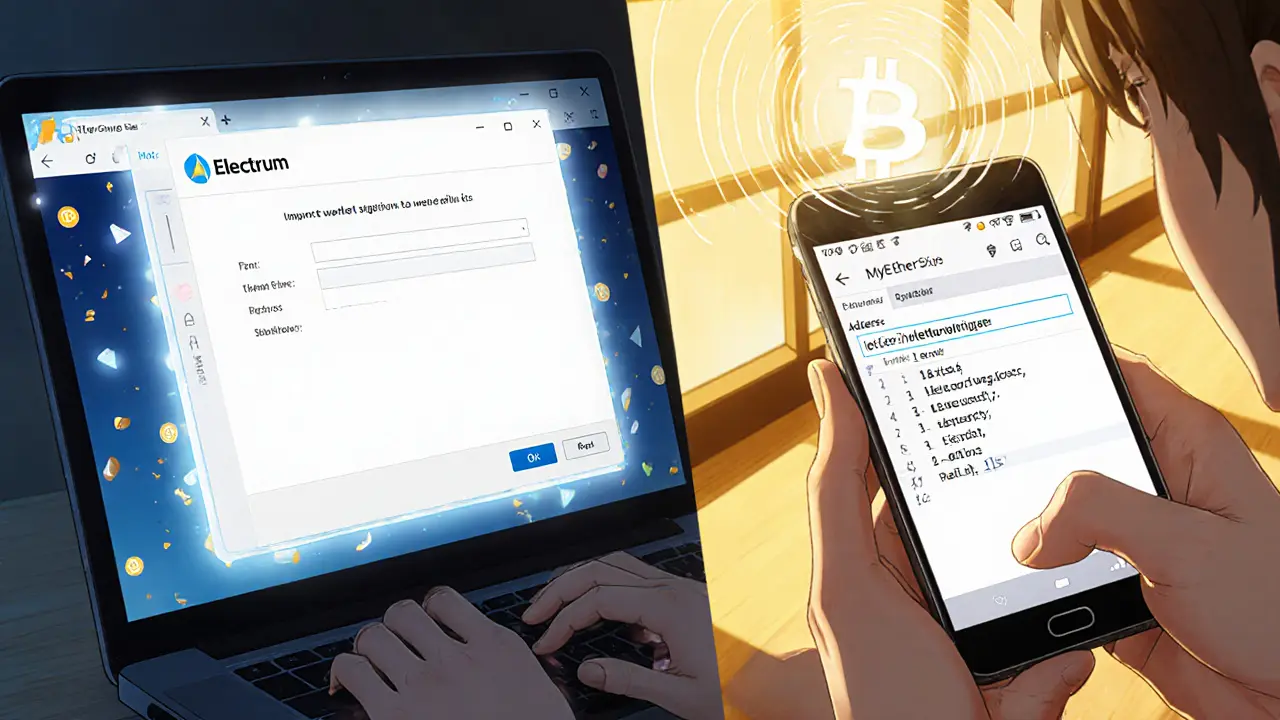Recovery Path Finder
Find Your Recovery Path
Select your wallet type and available recovery data to determine the best approach.
Recommended Recovery Path
Key Takeaways
- Knowing your seed phrase or private key is the single most reliable way to restore any non‑custodial wallet.
- Hardware wallets (Ledger, Trezor) rely on a 24‑word recovery phrase; losing it means the funds are essentially unrecoverable.
- Professional recovery services can help when you have partial data, but they never ask for upfront fees without a clear contract.
- Never trust unsolicited offers; scams claim 100% recovery rates but often steal more assets.
- Back up your recovery data in at least two physical forms (paper, metal) and one encrypted digital copy.
When you hear the term Cryptocurrency wallet recovery is the process of regaining access to digital assets after losing passwords, seed phrases, or the device that stores your private keys, the first question is: what kind of wallet are you dealing with? The answer decides which method you can actually use.
Understanding Wallet Types
Crypto wallets fall into two broad camps:
- Non‑custodial wallets - you own the private key. Examples include Electrum, MetaMask, and Trust Wallet. Loss of the key or seed phrase equals loss of funds.
- Custodial wallets - an exchange or service holds the keys for you. Coinbase, Binance, and Kraken fall here. Recovery usually involves email verification and identity checks.
Hardware devices like Ledger and Trezor are technically non‑custodial because the private key never leaves the device, but they add a physical layer of protection.
Core Recovery Ingredients
The three pieces of data you might still have when you’re locked out are:
- Seed phrase (12‑24 words). This is the master key to rebuild a wallet on any compatible software.
- Private key - a long alphanumeric string that directly signs transactions.
- Backup file - wallet.dat, keystore JSON, or a proprietary file that encrypts the private key.
If you have any one of these, a recovery path exists. If you have none, the chance of getting those coins back drops to near zero.

Recovery Methods by Wallet Type
Below is a quick guide for the most common wallets as of 2025.
| Wallet | Required Recovery Data | Typical Success Rate | Recommended Tool/Service |
|---|---|---|---|
| Electrum (desktop/mobile) | Seed phrase or wallet file | ~98% if seed phrase available | Electrum app import |
| MetaMask (browser/extension) | Secret Recovery Phrase or private key | ~95% with full phrase | MetaMask import screen |
| Ledger hardware | 24‑word recovery phrase | ~99% when phrase intact | Ledger Live - restore device |
| Trezor hardware | 12‑24‑word seed | ~99% with phrase | Trezor Suite - device reset |
| Trust Wallet (mobile) | Seed phrase or private key | ~94% with phrase | Trust import feature |
| Custodial exchange (Coinbase, Binance) | Email access + ID verification | ~90% when account not locked | Exchange support portal |
| Bitcoin Core (desktop) | wallet.dat file + optional passphrase | ~80% if file intact | Bitcoin Core - file restore |
Professional Recovery Services
When you only have a fragment of a seed phrase, a corrupt wallet file, or suspect theft, a professional service can add forensic muscle. Two reputable names in 2025 are:
- Xpress Crypto Recovery - uses blockchain forensics, transaction tracing, and legal liaison. They only charge after a successful retrieval.
- DataRecovery.com - focuses on corrupted device files and partial seed phrase reconstruction; offers a “no data, no charge” guarantee.
Both companies stress that they will never ask for your private key up front. They ask for read‑only access to the device or the backup file, then run offline analysis.
DIY Step‑by‑Step Guides
1. Seed Phrase Import (non‑custodial)
- Download a trusted wallet app that supports the same blockchain (e.g., Exodus for multi‑coin, Electrum for Bitcoin).
- Open the app and choose “Restore wallet” or “Import using seed phrase”.
- Enter the 12‑ or 24‑word phrase exactly as written. Watch out for similar‑looking words (e.g., “bunk” vs “bunch”).
- Set a strong new password; write it down separate from the seed phrase.
- Sync the blockchain; funds should appear within a few minutes for most coins.
2. Private Key Import
- Open the wallet that accepts raw private keys (e.g., MyEtherWallet for Ethereum).
- Select “Import Private Key” and paste the full string (starts with 0x for Ethereum).
- Confirm the address shown matches the one you expect.
- Transfer the balance to a freshly created wallet with a proper seed phrase.
3. Recovering a Corrupted Wallet File
- Make a copy of the damaged file on a separate storage device.
- Use a hex editor or a tool like “walletutil” to extract the encrypted payload.
- If you know the wallet password, run the decryption command (e.g.,
bitcoin-tool --wallet=wallet.dat --decrypt --password=YOURPASS). - Export the recovered private key and import it into a fresh wallet.
These steps work for users comfortable with command‑line tools; beginners should stick to the seed phrase route.

Prevention and Best Practices
Recovery is easier when you plan ahead. Follow these habits:
- Write the seed phrase on metal plates; store plates in two separate safe locations.
- Encrypt a digital copy with a strong passphrase (AES‑256) and keep it on an offline USB drive.
- Test the backup annually by restoring to a fresh device.
- Never share your seed phrase or private key with anyone, even support staff.
- Enable two‑factor authentication on any custodial exchange and keep the recovery email secure.
Scams to Watch Out For
Recovery scams exploded in 2024‑2025, targeting seniors and new investors. Red flags include:
- Requests for upfront payment in cryptocurrency.
- Promises of 100% recovery within hours.
- Unsolicited messages claiming to be from “FBI” or “exchange security”.
- Websites that mimic legitimate services but use a slightly different URL.
If you encounter any of these, stop immediately and report the incident to local law enforcement or consumer protection agencies.
Frequently Asked Questions
Can I recover funds without a seed phrase?
Only in limited cases. If you have the encrypted wallet file and remember the password, you can decrypt it and extract the private key. Otherwise, professional forensic services might piece together a partial phrase, but success is far from guaranteed.
How long does a professional recovery take?
Simple cases (full seed phrase) finish in minutes. Complex forensic investigations can run from a few weeks to several months, depending on data quality and whether law‑enforcement cooperation is needed.
Is it safe to give my backup file to a recovery service?
Choose a service that offers read‑only access and a clear “no data, no charge” policy. Reputable firms never ask for private keys or full seed phrases before establishing a contract.
What’s the best way to store a seed phrase?
Write it on a fire‑resistant metal plate, keep two copies in separate safe locations, and supplement with an encrypted digital backup stored offline.
Do hardware wallets need regular firmware updates for recovery?
Updates improve security but do not affect the 24‑word recovery phrase. If the device dies, you can restore on any compatible hardware using the phrase alone.
Recovery isn’t magic; it’s a process that starts with good data. Keep your seed phrase safe, verify any service you hire, and stay away from anyone promising instant miracles. With the right prep, you’ll never lose access to your crypto again.






Schuyler Whetstone
April 4, 2025 AT 10:59 AMIf you ain't keepin your seed phrase in a fire‑proof safe, you're just askin for crypto theft.
David Moss
April 9, 2025 AT 10:59 AMLook, the real danger isn’t just a lost phrase-it’s the shadow agencies that infiltrate your wallet while you’re busy scrolling… they know every back‑door, yet they pretend it’s “just a scam”. They’ll quote “official” support emails, but those are fabricated; always verify the URL, and never trust a DM that claims to be from the FBI. In my experience, the only safe path is offline storage and a cold‑air‑gapped backup.
Pierce O'Donnell
April 14, 2025 AT 10:59 AMPeople love to hype “instant recovery” services, but most of them are just smoke and mirrors. If you don’t have the seed phrase, you’re basically staring at a brick wall. The reality is simple: either you have the cryptographic key or you don’t.
Katharine Sipio
April 19, 2025 AT 10:59 AMThank you for sharing this comprehensive guide. It is heartening to see such clear steps laid out for both newcomers and seasoned users alike. Your emphasis on physical backups and regular testing is particularly valuable. Please continue to keep the community informed.
Deepak Kumar
April 24, 2025 AT 10:59 AMFirst and foremost, always treat your seed phrase like the crown jewels; store it in at least two separate, fire‑proof locations. Never, under any circumstance, keep a digital copy on a cloud service without strong, offline‑only encryption. If you’ve already lost access to a device, start by locating any printed backup-paper, metal, or even a laminated card. Should you only have fragments of the phrase, write down exactly what you remember and use a word‑list tool to iterate possible combinations; this process can be time‑consuming but often yields results. Next, if you possess the encrypted wallet file, create a checksum of the file before attempting any decryption; this protects you from accidental corruption. Use a reputable tool like walletutil or bitcoin‑tool to extract the payload, and remember to run the decryption command on an offline, air‑gapped machine. When entering passwords, double‑check for common typos-many failures stem from a misplaced character. If you manage to retrieve the private key, immediately import it into a fresh, secure wallet that you set up with a brand‑new seed phrase. After restoration, transfer all assets to the new wallet; never leave them in the compromised environment. For hardware wallets, if the device itself is dead, you can still recover using the 24‑word phrase on any compatible device-Ledger Live, Trezor Suite, or even a software emulator. Always test your backup at least once a year: simulate a recovery on a spare laptop to verify that the phrase works and that you can access your funds. In the case of custodial exchanges, ensure your recovery email and phone number are up‑to‑date; enable two‑factor authentication with an authenticator app rather than SMS. If you ever encounter a recovery service that asks for an upfront payment in crypto, walk away-they’re almost certainly a scam. Reputable services operate on a “no data, no charge” basis and will never request your full seed phrase outright. Finally, keep a detailed log of where each backup resides; a simple spreadsheet (encrypted, of course) can save you hours of frantic searching during an emergency. Following these habits will dramatically reduce the odds of permanent loss and give you peace of mind knowing your assets are recoverable.
Matthew Theuma
April 29, 2025 AT 10:59 AMInteresting read-nothing too flashy, just solid advice. I appreciate the step‑by‑step tone, and it reminds me of the old days when we used hex editors for fun. 🙂 Just watch out for typos in the copy‑paste sections; a single wrong character can lock you out.
Carolyn Pritchett
May 4, 2025 AT 10:59 AMThis post is a textbook example of fear‑mongering wrapped in “expert” jargon. Most people will never need a forensic lab to recover a simple seed phrase. Stop trying to sell panic.
Cecilia Cecilia
May 9, 2025 AT 10:59 AMI understand the concerns raised and appreciate the clear presentation of preventive steps.
lida norman
May 14, 2025 AT 10:59 AMWow, this guide really hits home! 😱 It’s like a lifeline when the crypto world feels like a maze. Thank you for the clarity! 🙏